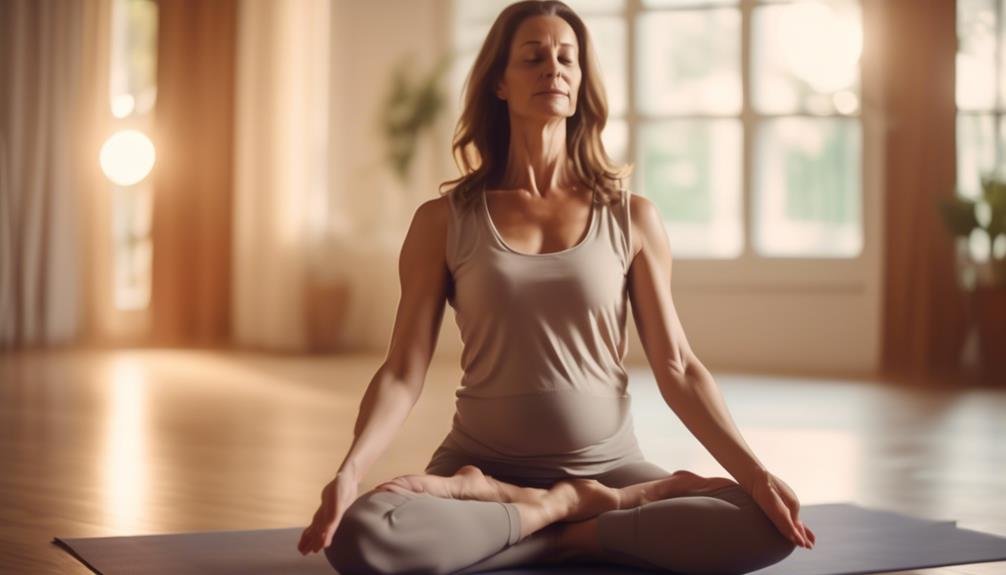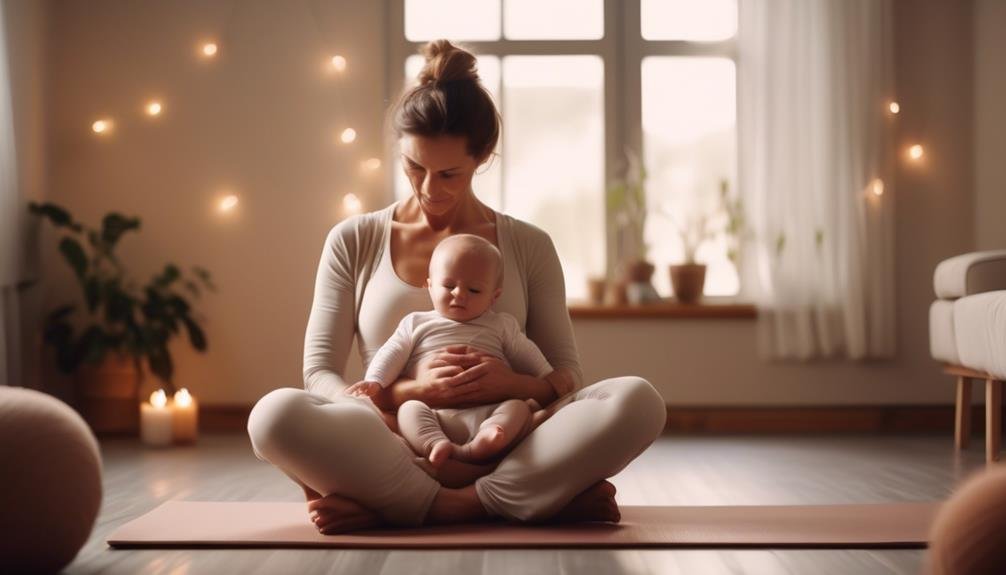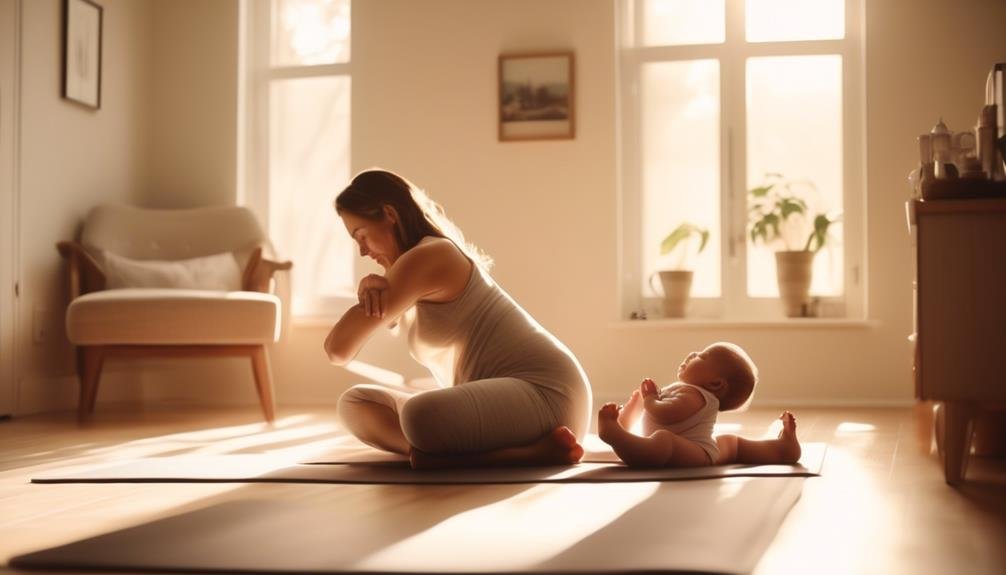"Cherishing Little Steps - A Haven for Baby and Family Journeys"
Easy Postnatal Stretching Routines
Are you a new parent, feeling exhausted yet exhilarated by the incredible journey of bringing new life into the world? As you navigate the challenges of postnatal recovery, finding time for self-care may seem like an impossible task.
But what if we told you that there is a simple and effective way to ease your tired muscles and soothe your mind? In this discussion, we will explore easy postnatal stretching routines that can help you regain strength, improve flexibility, and promote overall well-being.
So, if you're ready to discover a gentle and rejuvenating practice that can support your postpartum journey, let's dive in.
Key Takeaways
- Postnatal stretching can provide numerous benefits such as increased flexibility, alleviating muscle and joint tightness, preparing the body for intense workouts, and improving posture.
- Upper body stretches like shoulder rolls, chest opener, and arm across chest stretch can help release tension in shoulder muscles, improve blood circulation, stretch chest muscles, and improve posture.
- Lower body stretches such as standing forward bend, butterfly stretch, and wall calf stretch can stretch hamstrings, calves, lower back, open up hips, stretch inner thighs, stretch calf muscles, and improve leg strength.
- Core and pelvic floor stretches like pelvic tilts, bridge pose, and cat-cow stretch can engage core and pelvic floor muscles, strengthen glutes and core, and release tension in the back and neck.
Benefits of Postnatal Stretching

Postnatal stretching offers numerous benefits that can support your postpartum recovery and overall well-being. After giving birth, your body goes through significant changes, and stretching can help you regain flexibility and improve your posture.
One of the key benefits of postnatal stretching is increased flexibility. Pregnancy can cause tightness in your muscles and joints, and stretching can help alleviate this. By incorporating gentle stretches into your routine, you can gradually improve your range of motion and regain the flexibility you'd before pregnancy. This increased flexibility not only helps with everyday activities but also prepares your body for more intense workouts if you choose to engage in them later on.
Additionally, postnatal stretching can also improve your posture. During pregnancy, your growing belly often leads to changes in your posture to accommodate the extra weight. This can result in rounded shoulders and a forward-leaning stance. By incorporating specific stretches that target the muscles responsible for good posture, you can gradually correct these imbalances and stand taller and more aligned.
Incorporating postnatal stretching into your daily routine can have a profound impact on your postpartum recovery journey. Not only will it help you regain your flexibility, but it will also improve your posture, allowing you to move with ease and confidence.
Upper Body Stretches

As you continue your postnatal recovery journey, let's now focus on incorporating upper body stretches into your routine to further support your overall well-being.
After giving birth, your body may feel tight and tense, especially in your shoulders and chest. These stretches will help relieve tension, improve flexibility, and promote relaxation.
Here are three simple upper body stretches you can try:
- Shoulder Rolls: Stand or sit up straight and roll your shoulders forward and backward in a circular motion. This exercise helps release tension in your shoulder muscles and improves blood circulation.
- Chest Opener: Stand tall with your feet hip-width apart and interlace your fingers behind your back. Gently squeeze your shoulder blades together and lift your chest towards the ceiling. Hold this position for a few breaths to stretch your chest muscles and open up your posture.
- Arm Across Chest Stretch: Extend one arm in front of you and bring it across your chest. Use your other arm to gently pull it closer to your body, feeling a stretch in your shoulder and upper back. Hold for 20-30 seconds on each side.
Lower Body Stretches
To enhance your postnatal recovery and promote flexibility in your lower body, incorporate these simple and effective stretches into your routine. After giving birth, it's important to focus on rebuilding your strength and improving your hip flexibility. These lower body stretches will not only help you regain your pre-pregnancy mobility but also strengthen your legs for the demands of motherhood.
Here are some recommended stretches for your lower body:
| Stretch | Instructions | Benefits |
|---|---|---|
| Standing Forward Bend | Stand with your feet hip-width apart. Slowly bend forward from your hips, reaching towards the ground. Hold for 30 seconds. | Stretches the hamstrings, calves, and lower back. Increases blood flow to the legs. |
| Butterfly Stretch | Sit on the floor with your soles of the feet touching each other. Gently press your knees toward the ground. Hold for 30 seconds. | Opens up the hips and stretches the inner thighs. Improves hip flexibility. |
| Wall Calf Stretch | Stand facing a wall. Place your hands on the wall at shoulder height. Step one foot back and keep it straight. Lean forward, feeling a stretch in the calf of the back leg. Hold for 30 seconds. | Stretches the calf muscles and improves leg strength. Helps prevent calf tightness and cramps. |
Incorporating these lower body stretches into your postnatal routine will not only improve your hip flexibility but also enhance your leg strength. Take the time for yourself and prioritize your recovery. Your body will thank you, and you'll be better equipped to handle the demands of motherhood.
Core and Pelvic Floor Stretches
Are you looking to strengthen your core and pelvic floor after giving birth? It's important to prioritize your postnatal recovery and focus on rebuilding your strength. Here are three core and pelvic floor stretching exercises to help you on your journey:
- Pelvic Tilts: Start by lying on your back with your knees bent and feet flat on the floor. Gently tilt your pelvis forward and backward, engaging your core and pelvic floor muscles. Repeat this movement for 10-15 repetitions.
- Bridge Pose: Lie on your back with your knees bent and feet flat on the floor. Slowly lift your hips off the ground, squeezing your glutes and engaging your core. Hold this position for a few seconds and then slowly lower your hips back down. Repeat this exercise for 10-12 repetitions.
- Cat-Cow Stretch: Get down on all fours with your hands directly under your shoulders and your knees under your hips. Inhale as you arch your back and look up, allowing your belly to drop towards the floor. Exhale as you round your back and tuck your chin towards your chest. Repeat this flow for 8-10 repetitions.
Relaxation and Stress Relief Stretches

If you're in need of some relaxation and stress relief after giving birth, incorporating stretching exercises into your routine can be incredibly beneficial. As a new mom, it's important to take care of both your physical and mental well-being. Relaxation techniques and breathing exercises can help you find calmness and reduce stress levels.
One great stretch for relaxation is the Child's Pose. Start by kneeling on the floor with your knees apart and toes touching. Slowly lower your upper body down and rest your forehead on the mat. Reach your arms forward and feel the gentle stretch in your back and hips. Take deep breaths in and out, allowing yourself to let go of any tension.
Another wonderful stretch is the Cat-Cow pose. Begin on all fours with your hands directly under your shoulders and your knees under your hips. As you inhale, arch your back and lift your head up, creating a gentle curve. As you exhale, round your spine and tuck your chin to your chest. Repeat this flow, syncing your breath with the movement, to release tension in your back and neck.
Remember to listen to your body and never push yourself too far. These stretches are meant to help you relax and find peace during this busy and sometimes overwhelming time. Take a few minutes each day to focus on yourself and prioritize self-care. Your body and mind will thank you.
Stretching With Baby

After finding relaxation and stress relief through stretching exercises, it's time to explore how you can incorporate your baby into your stretching routine. Stretching with your baby not only allows you to bond with your little one, but it also provides gentle exercises that can benefit both of you.
Here are three bonding activities and gentle exercises you can try with your baby:
- Baby Yoga: Incorporate your baby into your yoga routine by gently stretching their arms and legs. This not only helps improve their flexibility but also allows for physical interaction and connection between you and your baby.
- Mommy-Baby Stretches: Lie on your back with your baby lying on your chest. Slowly lift your legs up, bending at the knees, and gently bring them towards your chest. This stretch helps to strengthen your core muscles while also providing a gentle massage for your baby's back.
- Baby Massage: After your stretching routine, take some time to give your baby a soothing massage. Use gentle strokes and circular motions on their arms, legs, and back. This not only helps them relax but also promotes healthy circulation and aids in their overall development.
Remember to always listen to your baby's cues and stop any activity if they seem uncomfortable. Stretching with your baby can be a beautiful way to bond and promote their physical well-being, so enjoy this special time together.
Tips for Incorporating Stretching Into Your Routine

To effectively incorporate stretching into your routine, it's important to establish a consistent schedule and create a dedicated space for your stretching practice. By doing so, you'll be more likely to make stretching a regular habit and reap its many benefits. Here are some tips to help you seamlessly integrate stretching into your busy schedule:
| TIP | DESCRIPTION |
|---|---|
| 1. Set a specific time | Choose a time of day that works best for you, whether it's in the morning to energize your day or in the evening to unwind and relax. Stick to this schedule as much as possible. |
| 2. Create a designated space | Find a quiet and comfortable area where you can stretch without interruptions. This can be a corner in your living room, a spare room, or even your backyard. Make it inviting by adding some soothing music or candles. |
| 3. Start small and be consistent | Begin with simple stretching techniques for beginners and gradually increase the duration and intensity as you become more comfortable. Aim for at least 10-15 minutes of stretching every day or every other day. Remember, consistency is key! |
Incorporating stretching into your routine doesn't have to be overwhelming. By following these tips, you can make it a seamless part of your day, even with a busy schedule. Remember to listen to your body and take it slow. With time and practice, you'll start to experience the incredible benefits of regular stretching. So go ahead, carve out that dedicated space and make stretching a priority in your life.
Frequently Asked Questions
How Soon Can I Start Postnatal Stretching After Giving Birth?
You can start postnatal stretching soon after giving birth. It has many benefits, like improving flexibility and relieving muscle tension. There are various techniques you can try to gradually ease into your routine.
Can Postnatal Stretching Help With Diastasis Recti?
Postnatal stretching can effectively help with diastasis recti, a condition where your abdominal muscles separate. Strengthening exercises like pelvic tilts and modified planks can reduce the gap between the muscles and improve core stability.
Are There Any Precautions I Should Take While Performing Postnatal Stretches?
When performing postnatal stretches, it's important to take precautions to ensure your safety. Listen to your body, start slowly, and avoid any movements that cause discomfort. Postnatal stretching benefits your body, so aim for a recommended frequency of 3-5 times per week.
Can Postnatal Stretching Help With Postpartum Depression?
Postnatal stretching can be beneficial for postpartum depression. It helps release endorphins, reduces stress, and promotes relaxation. Incorporating postnatal stretching into your routine can play a role in improving your mental health.
How Long Should I Hold Each Stretch During a Postnatal Stretching Routine?
Hold each stretch for about 20-30 seconds, focusing on proper breathing techniques. This allows your muscles to fully relax and increases the benefits of postnatal stretching. Remember, taking care of your body is important for your well-being.
Conclusion
So there you have it, new moms! Stretching after having a baby not only helps you regain flexibility and strength, but it's also a great way to relax and relieve stress.
Plus, it's a perfect opportunity to bond with your little one while they giggle and play along.
So don't forget to incorporate these easy postnatal stretching routines into your daily routine. Trust me, you'll thank me later when you can touch your toes and chase after your toddler at the same time!



major brand allergy pills prescription allergy medicine list otc allergy medication comparison chart
strongest sleeping pills at walgreens phenergan oral
prednisone 40mg brand cost prednisone 40mg
best medicine for acid indigestion cheap lincocin 500 mg
acne treatment for teens dermatology zovirax usa best teen acne treatment products
prescription med for abdominal cramps quinapril cost
purchase isotretinoin for sale accutane ca buy isotretinoin 10mg generic
top 10 strongest sleeping pills buy generic provigil
order amoxil 1000mg pill order amoxicillin 1000mg online amoxil 500mg sale
order zithromax 250mg pill buy azithromycin 250mg for sale zithromax ca
order gabapentin generic buy gabapentin 800mg online cheap
azithromycin 250mg over the counter buy generic azithromycin buy azithromycin pills for sale
how to get furosemide without a prescription lasix for sale
order omnacortil 40mg pills prednisolone 20mg oral buy prednisolone cheap
buy deltasone online buy prednisone 5mg pill
amoxicillin ca amoxicillin ca order amoxicillin 500mg online cheap
buy doxycycline 100mg vibra-tabs brand
buy albuterol cheap order ventolin 2mg online cheap albuterol 2mg price
buy generic augmentin 625mg buy augmentin 625mg online cheap
synthroid 150mcg sale purchase synthroid pills levothroid oral
order vardenafil 20mg generic buy vardenafil paypal
clomiphene 100mg pill cost clomiphene 100mg order generic serophene
buy cheap generic semaglutide buy semaglutide 14mg without prescription semaglutide 14mg pills
rybelsus where to buy order rybelsus generic buy semaglutide 14mg without prescription
order prednisone 5mg online deltasone order purchase deltasone generic
cost accutane isotretinoin 20mg oral accutane canada
order albuterol 4mg for sale buy albuterol pill purchase albuterol inhalator without prescription
amoxicillin 1000mg without prescription amoxicillin 500mg cost cheap amoxil without prescription
order augmentin 625mg pill order amoxiclav online cheap augmentin 375mg generic
zithromax cheap purchase azithromycin order azithromycin 500mg
synthroid 150mcg tablet order synthroid 150mcg pill order synthroid 75mcg pill
purchase prednisolone online order generic omnacortil 20mg purchase omnacortil for sale
serophene order order clomid 50mg for sale order clomiphene 50mg pill
buy gabapentin without a prescription buy gabapentin 800mg for sale buy generic gabapentin
viagra 100mg price sildenafil 100mg purchase viagra online
order lasix 100mg without prescription buy furosemide generic diuretic lasix 100mg price
order semaglutide sale buy rybelsus 14 mg generic order semaglutide 14mg generic
purchase vardenafil generic vardenafil 10mg ca vardenafil 10mg sale
play online blackjack real money slots casino games where can i play poker online
order generic plaquenil plaquenil 200mg oral hydroxychloroquine 200mg cheap
buy pregabalin cheap buy lyrica paypal generic lyrica 75mg
purchase aristocort online cheap aristocort price cost triamcinolone 10mg
tadalafil generic name oral cialis 5mg generic tadalafil 40mg
clarinex 5mg usa clarinex us buy desloratadine 5mg generic
cenforce for sale order cenforce without prescription purchase cenforce pill
buy aralen no prescription aralen pills chloroquine online
order claritin 10mg pill claritin price loratadine 10mg generic
buy generic glycomet 500mg order glycomet 1000mg online cheap glucophage price
orlistat for sale buy diltiazem pill order diltiazem 180mg online cheap
order atorvastatin 40mg pills lipitor 80mg usa generic atorvastatin 10mg
amlodipine usa amlodipine 10mg uk buy cheap norvasc
order acyclovir 400mg pill how to buy zyloprim zyloprim oral
zestril 10mg generic lisinopril 10mg pills order lisinopril pill
order generic rosuvastatin 20mg ezetimibe price ezetimibe 10mg pill
omeprazole price order generic prilosec 10mg order prilosec 10mg sale
motilium without prescription buy generic motilium online tetracycline tablet
metoprolol online buy buy lopressor for sale buy lopressor cheap
cyclobenzaprine oral buy baclofen pills for sale cheap ozobax
cost tenormin 100mg order atenolol 50mg without prescription atenolol 50mg cheap